Managing Diversity at CERA: Human Resource Management
VerifiedAdded on 2023/06/06
|13
|4001
|203
AI Summary
The report was prepared to discuss about the different aspects of managing human resources at the organization named CERA in Australia. The focus of the report was on the business rationale for the management of diversity along with the various policies associated with it to derive the best possible outcomes in business.
Contribute Materials
Your contribution can guide someone’s learning journey. Share your
documents today.
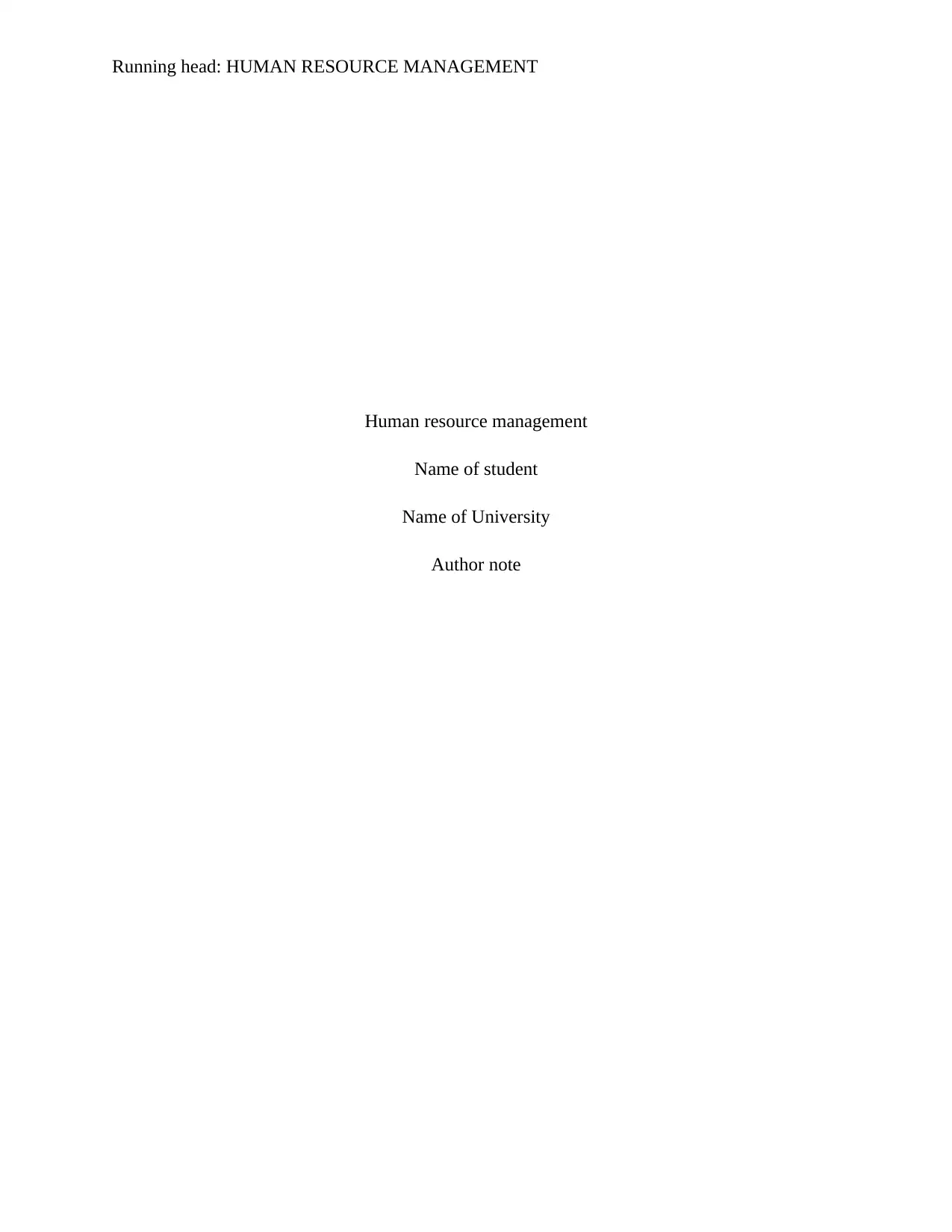
Running head: HUMAN RESOURCE MANAGEMENT
Human resource management
Name of student
Name of University
Author note
Human resource management
Name of student
Name of University
Author note
Secure Best Marks with AI Grader
Need help grading? Try our AI Grader for instant feedback on your assignments.
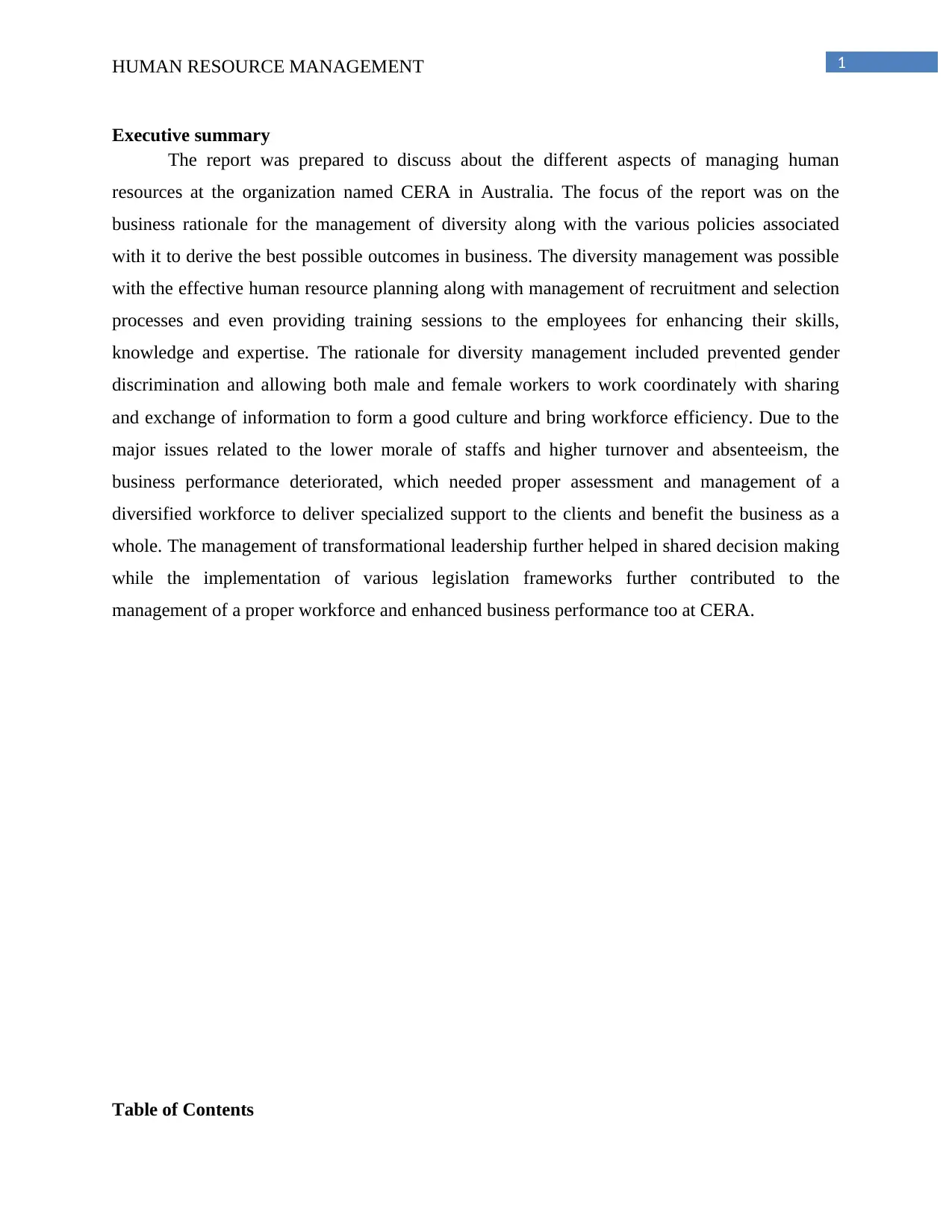
1HUMAN RESOURCE MANAGEMENT
Executive summary
The report was prepared to discuss about the different aspects of managing human
resources at the organization named CERA in Australia. The focus of the report was on the
business rationale for the management of diversity along with the various policies associated
with it to derive the best possible outcomes in business. The diversity management was possible
with the effective human resource planning along with management of recruitment and selection
processes and even providing training sessions to the employees for enhancing their skills,
knowledge and expertise. The rationale for diversity management included prevented gender
discrimination and allowing both male and female workers to work coordinately with sharing
and exchange of information to form a good culture and bring workforce efficiency. Due to the
major issues related to the lower morale of staffs and higher turnover and absenteeism, the
business performance deteriorated, which needed proper assessment and management of a
diversified workforce to deliver specialized support to the clients and benefit the business as a
whole. The management of transformational leadership further helped in shared decision making
while the implementation of various legislation frameworks further contributed to the
management of a proper workforce and enhanced business performance too at CERA.
Table of Contents
Executive summary
The report was prepared to discuss about the different aspects of managing human
resources at the organization named CERA in Australia. The focus of the report was on the
business rationale for the management of diversity along with the various policies associated
with it to derive the best possible outcomes in business. The diversity management was possible
with the effective human resource planning along with management of recruitment and selection
processes and even providing training sessions to the employees for enhancing their skills,
knowledge and expertise. The rationale for diversity management included prevented gender
discrimination and allowing both male and female workers to work coordinately with sharing
and exchange of information to form a good culture and bring workforce efficiency. Due to the
major issues related to the lower morale of staffs and higher turnover and absenteeism, the
business performance deteriorated, which needed proper assessment and management of a
diversified workforce to deliver specialized support to the clients and benefit the business as a
whole. The management of transformational leadership further helped in shared decision making
while the implementation of various legislation frameworks further contributed to the
management of a proper workforce and enhanced business performance too at CERA.
Table of Contents
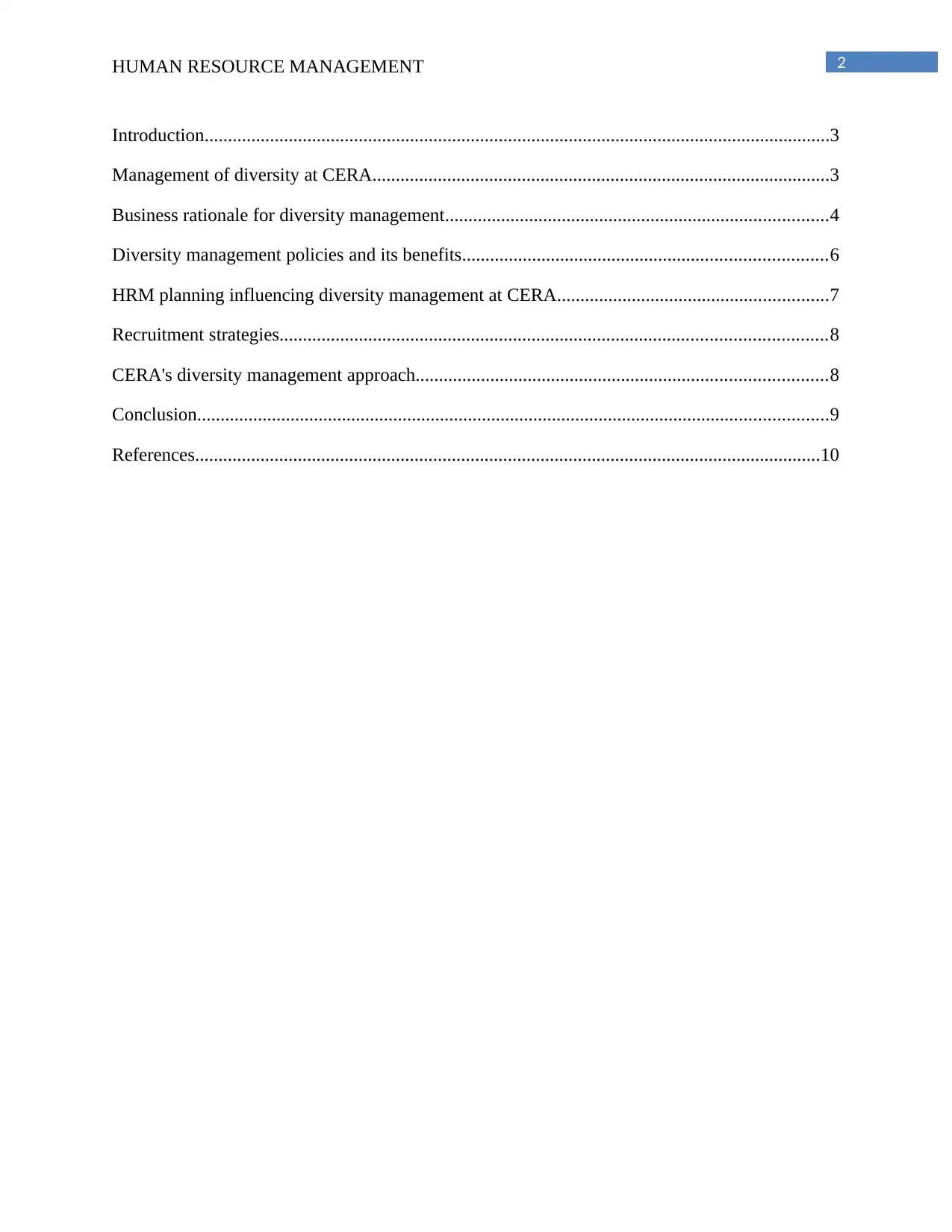
2HUMAN RESOURCE MANAGEMENT
Introduction......................................................................................................................................3
Management of diversity at CERA..................................................................................................3
Business rationale for diversity management..................................................................................4
Diversity management policies and its benefits..............................................................................6
HRM planning influencing diversity management at CERA..........................................................7
Recruitment strategies.....................................................................................................................8
CERA's diversity management approach........................................................................................8
Conclusion.......................................................................................................................................9
References......................................................................................................................................10
Introduction......................................................................................................................................3
Management of diversity at CERA..................................................................................................3
Business rationale for diversity management..................................................................................4
Diversity management policies and its benefits..............................................................................6
HRM planning influencing diversity management at CERA..........................................................7
Recruitment strategies.....................................................................................................................8
CERA's diversity management approach........................................................................................8
Conclusion.......................................................................................................................................9
References......................................................................................................................................10
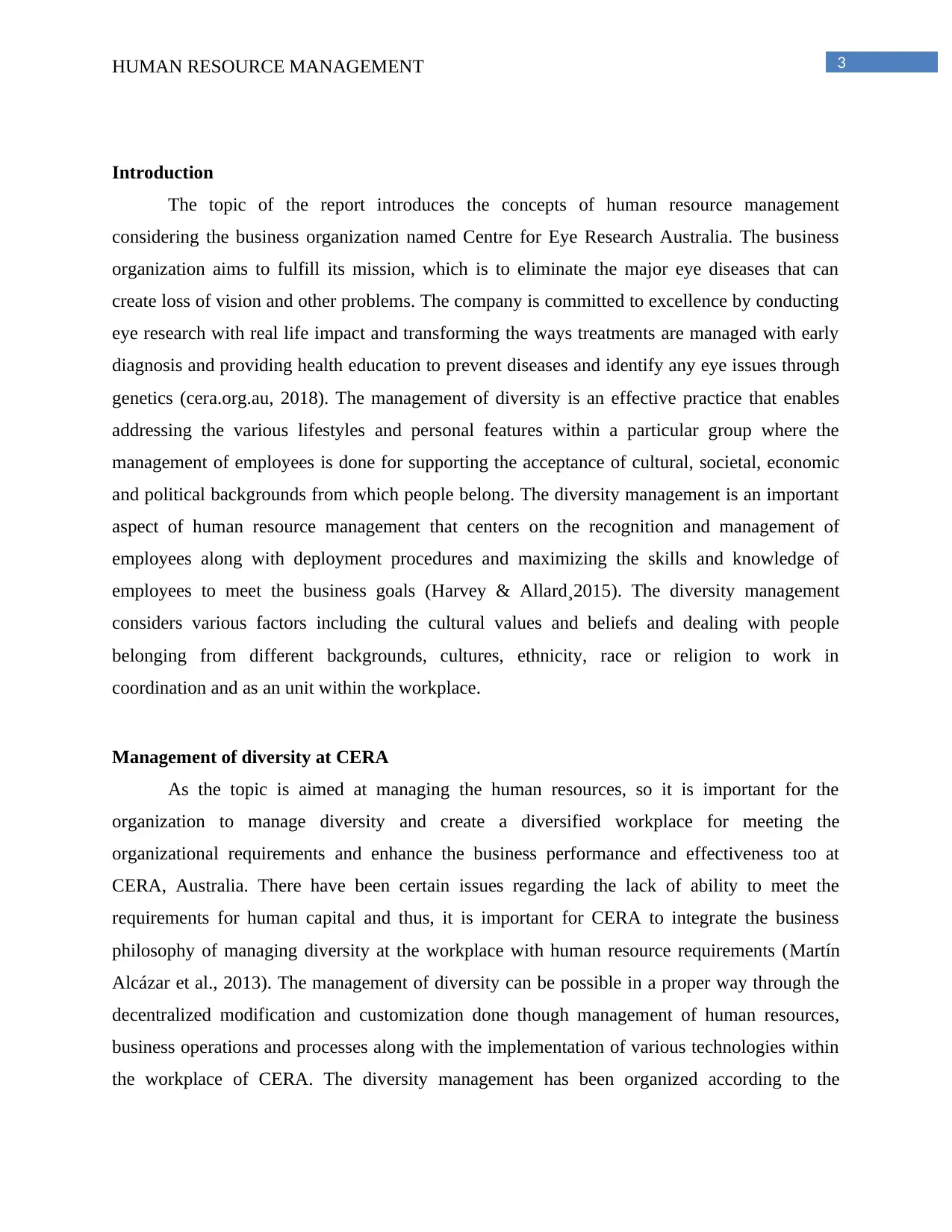
3HUMAN RESOURCE MANAGEMENT
Introduction
The topic of the report introduces the concepts of human resource management
considering the business organization named Centre for Eye Research Australia. The business
organization aims to fulfill its mission, which is to eliminate the major eye diseases that can
create loss of vision and other problems. The company is committed to excellence by conducting
eye research with real life impact and transforming the ways treatments are managed with early
diagnosis and providing health education to prevent diseases and identify any eye issues through
genetics (cera.org.au, 2018). The management of diversity is an effective practice that enables
addressing the various lifestyles and personal features within a particular group where the
management of employees is done for supporting the acceptance of cultural, societal, economic
and political backgrounds from which people belong. The diversity management is an important
aspect of human resource management that centers on the recognition and management of
employees along with deployment procedures and maximizing the skills and knowledge of
employees to meet the business goals (Harvey & Allard¸2015). The diversity management
considers various factors including the cultural values and beliefs and dealing with people
belonging from different backgrounds, cultures, ethnicity, race or religion to work in
coordination and as an unit within the workplace.
Management of diversity at CERA
As the topic is aimed at managing the human resources, so it is important for the
organization to manage diversity and create a diversified workplace for meeting the
organizational requirements and enhance the business performance and effectiveness too at
CERA, Australia. There have been certain issues regarding the lack of ability to meet the
requirements for human capital and thus, it is important for CERA to integrate the business
philosophy of managing diversity at the workplace with human resource requirements (Martín
Alcázar et al., 2013). The management of diversity can be possible in a proper way through the
decentralized modification and customization done though management of human resources,
business operations and processes along with the implementation of various technologies within
the workplace of CERA. The diversity management has been organized according to the
Introduction
The topic of the report introduces the concepts of human resource management
considering the business organization named Centre for Eye Research Australia. The business
organization aims to fulfill its mission, which is to eliminate the major eye diseases that can
create loss of vision and other problems. The company is committed to excellence by conducting
eye research with real life impact and transforming the ways treatments are managed with early
diagnosis and providing health education to prevent diseases and identify any eye issues through
genetics (cera.org.au, 2018). The management of diversity is an effective practice that enables
addressing the various lifestyles and personal features within a particular group where the
management of employees is done for supporting the acceptance of cultural, societal, economic
and political backgrounds from which people belong. The diversity management is an important
aspect of human resource management that centers on the recognition and management of
employees along with deployment procedures and maximizing the skills and knowledge of
employees to meet the business goals (Harvey & Allard¸2015). The diversity management
considers various factors including the cultural values and beliefs and dealing with people
belonging from different backgrounds, cultures, ethnicity, race or religion to work in
coordination and as an unit within the workplace.
Management of diversity at CERA
As the topic is aimed at managing the human resources, so it is important for the
organization to manage diversity and create a diversified workplace for meeting the
organizational requirements and enhance the business performance and effectiveness too at
CERA, Australia. There have been certain issues regarding the lack of ability to meet the
requirements for human capital and thus, it is important for CERA to integrate the business
philosophy of managing diversity at the workplace with human resource requirements (Martín
Alcázar et al., 2013). The management of diversity can be possible in a proper way through the
decentralized modification and customization done though management of human resources,
business operations and processes along with the implementation of various technologies within
the workplace of CERA. The diversity management has been organized according to the
Secure Best Marks with AI Grader
Need help grading? Try our AI Grader for instant feedback on your assignments.
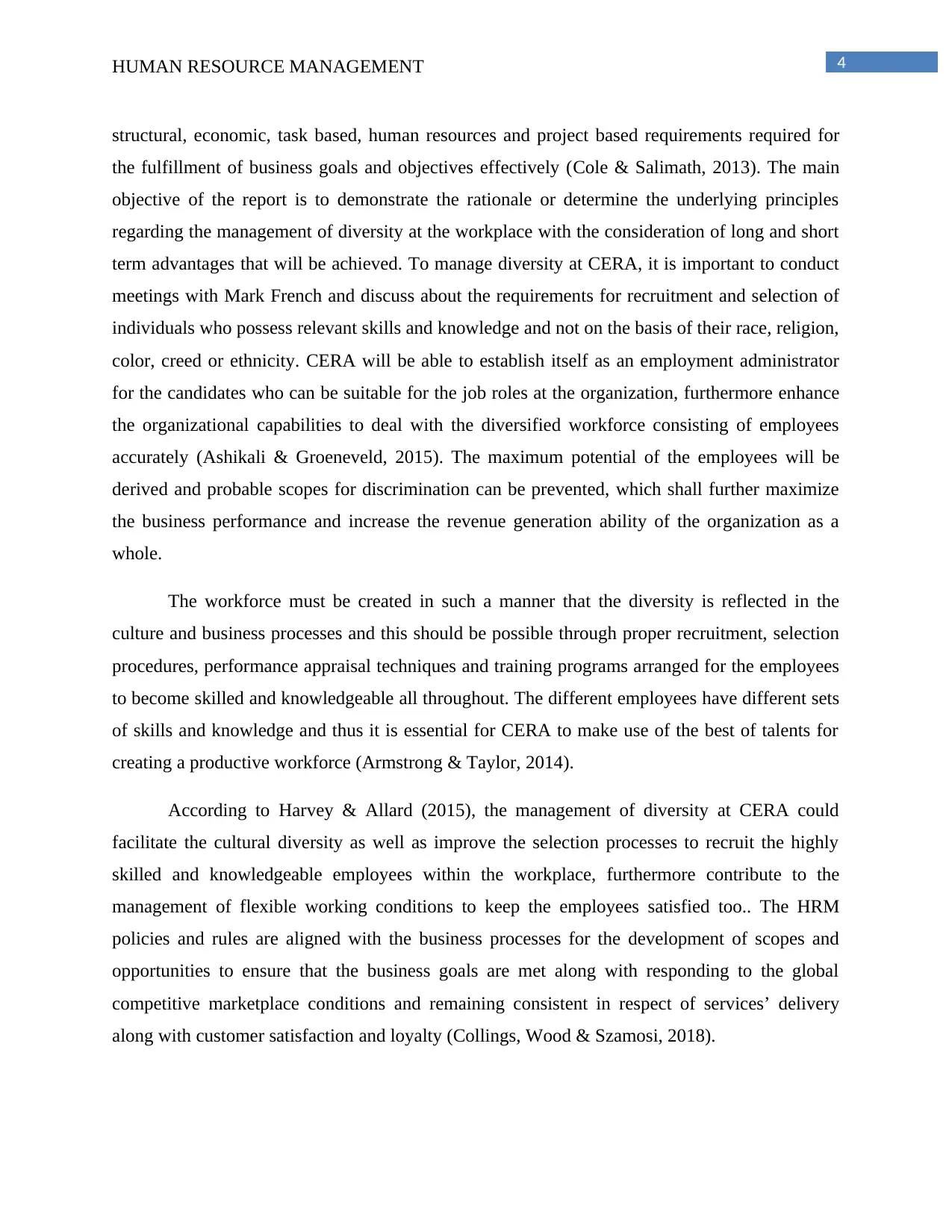
4HUMAN RESOURCE MANAGEMENT
structural, economic, task based, human resources and project based requirements required for
the fulfillment of business goals and objectives effectively (Cole & Salimath, 2013). The main
objective of the report is to demonstrate the rationale or determine the underlying principles
regarding the management of diversity at the workplace with the consideration of long and short
term advantages that will be achieved. To manage diversity at CERA, it is important to conduct
meetings with Mark French and discuss about the requirements for recruitment and selection of
individuals who possess relevant skills and knowledge and not on the basis of their race, religion,
color, creed or ethnicity. CERA will be able to establish itself as an employment administrator
for the candidates who can be suitable for the job roles at the organization, furthermore enhance
the organizational capabilities to deal with the diversified workforce consisting of employees
accurately (Ashikali & Groeneveld, 2015). The maximum potential of the employees will be
derived and probable scopes for discrimination can be prevented, which shall further maximize
the business performance and increase the revenue generation ability of the organization as a
whole.
The workforce must be created in such a manner that the diversity is reflected in the
culture and business processes and this should be possible through proper recruitment, selection
procedures, performance appraisal techniques and training programs arranged for the employees
to become skilled and knowledgeable all throughout. The different employees have different sets
of skills and knowledge and thus it is essential for CERA to make use of the best of talents for
creating a productive workforce (Armstrong & Taylor, 2014).
According to Harvey & Allard (2015), the management of diversity at CERA could
facilitate the cultural diversity as well as improve the selection processes to recruit the highly
skilled and knowledgeable employees within the workplace, furthermore contribute to the
management of flexible working conditions to keep the employees satisfied too.. The HRM
policies and rules are aligned with the business processes for the development of scopes and
opportunities to ensure that the business goals are met along with responding to the global
competitive marketplace conditions and remaining consistent in respect of services’ delivery
along with customer satisfaction and loyalty (Collings, Wood & Szamosi, 2018).
structural, economic, task based, human resources and project based requirements required for
the fulfillment of business goals and objectives effectively (Cole & Salimath, 2013). The main
objective of the report is to demonstrate the rationale or determine the underlying principles
regarding the management of diversity at the workplace with the consideration of long and short
term advantages that will be achieved. To manage diversity at CERA, it is important to conduct
meetings with Mark French and discuss about the requirements for recruitment and selection of
individuals who possess relevant skills and knowledge and not on the basis of their race, religion,
color, creed or ethnicity. CERA will be able to establish itself as an employment administrator
for the candidates who can be suitable for the job roles at the organization, furthermore enhance
the organizational capabilities to deal with the diversified workforce consisting of employees
accurately (Ashikali & Groeneveld, 2015). The maximum potential of the employees will be
derived and probable scopes for discrimination can be prevented, which shall further maximize
the business performance and increase the revenue generation ability of the organization as a
whole.
The workforce must be created in such a manner that the diversity is reflected in the
culture and business processes and this should be possible through proper recruitment, selection
procedures, performance appraisal techniques and training programs arranged for the employees
to become skilled and knowledgeable all throughout. The different employees have different sets
of skills and knowledge and thus it is essential for CERA to make use of the best of talents for
creating a productive workforce (Armstrong & Taylor, 2014).
According to Harvey & Allard (2015), the management of diversity at CERA could
facilitate the cultural diversity as well as improve the selection processes to recruit the highly
skilled and knowledgeable employees within the workplace, furthermore contribute to the
management of flexible working conditions to keep the employees satisfied too.. The HRM
policies and rules are aligned with the business processes for the development of scopes and
opportunities to ensure that the business goals are met along with responding to the global
competitive marketplace conditions and remaining consistent in respect of services’ delivery
along with customer satisfaction and loyalty (Collings, Wood & Szamosi, 2018).
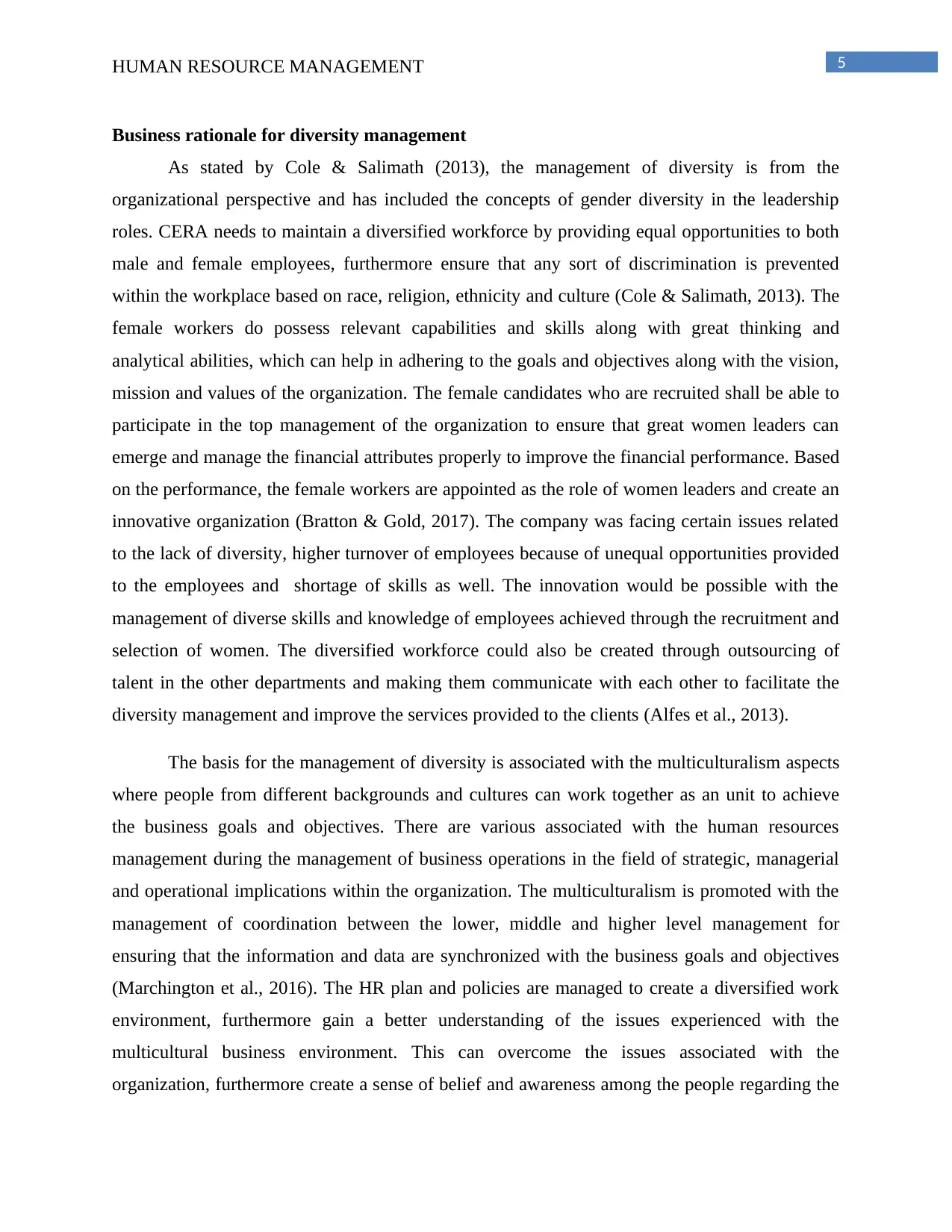
5HUMAN RESOURCE MANAGEMENT
Business rationale for diversity management
As stated by Cole & Salimath (2013), the management of diversity is from the
organizational perspective and has included the concepts of gender diversity in the leadership
roles. CERA needs to maintain a diversified workforce by providing equal opportunities to both
male and female employees, furthermore ensure that any sort of discrimination is prevented
within the workplace based on race, religion, ethnicity and culture (Cole & Salimath, 2013). The
female workers do possess relevant capabilities and skills along with great thinking and
analytical abilities, which can help in adhering to the goals and objectives along with the vision,
mission and values of the organization. The female candidates who are recruited shall be able to
participate in the top management of the organization to ensure that great women leaders can
emerge and manage the financial attributes properly to improve the financial performance. Based
on the performance, the female workers are appointed as the role of women leaders and create an
innovative organization (Bratton & Gold, 2017). The company was facing certain issues related
to the lack of diversity, higher turnover of employees because of unequal opportunities provided
to the employees and shortage of skills as well. The innovation would be possible with the
management of diverse skills and knowledge of employees achieved through the recruitment and
selection of women. The diversified workforce could also be created through outsourcing of
talent in the other departments and making them communicate with each other to facilitate the
diversity management and improve the services provided to the clients (Alfes et al., 2013).
The basis for the management of diversity is associated with the multiculturalism aspects
where people from different backgrounds and cultures can work together as an unit to achieve
the business goals and objectives. There are various associated with the human resources
management during the management of business operations in the field of strategic, managerial
and operational implications within the organization. The multiculturalism is promoted with the
management of coordination between the lower, middle and higher level management for
ensuring that the information and data are synchronized with the business goals and objectives
(Marchington et al., 2016). The HR plan and policies are managed to create a diversified work
environment, furthermore gain a better understanding of the issues experienced with the
multicultural business environment. This can overcome the issues associated with the
organization, furthermore create a sense of belief and awareness among the people regarding the
Business rationale for diversity management
As stated by Cole & Salimath (2013), the management of diversity is from the
organizational perspective and has included the concepts of gender diversity in the leadership
roles. CERA needs to maintain a diversified workforce by providing equal opportunities to both
male and female employees, furthermore ensure that any sort of discrimination is prevented
within the workplace based on race, religion, ethnicity and culture (Cole & Salimath, 2013). The
female workers do possess relevant capabilities and skills along with great thinking and
analytical abilities, which can help in adhering to the goals and objectives along with the vision,
mission and values of the organization. The female candidates who are recruited shall be able to
participate in the top management of the organization to ensure that great women leaders can
emerge and manage the financial attributes properly to improve the financial performance. Based
on the performance, the female workers are appointed as the role of women leaders and create an
innovative organization (Bratton & Gold, 2017). The company was facing certain issues related
to the lack of diversity, higher turnover of employees because of unequal opportunities provided
to the employees and shortage of skills as well. The innovation would be possible with the
management of diverse skills and knowledge of employees achieved through the recruitment and
selection of women. The diversified workforce could also be created through outsourcing of
talent in the other departments and making them communicate with each other to facilitate the
diversity management and improve the services provided to the clients (Alfes et al., 2013).
The basis for the management of diversity is associated with the multiculturalism aspects
where people from different backgrounds and cultures can work together as an unit to achieve
the business goals and objectives. There are various associated with the human resources
management during the management of business operations in the field of strategic, managerial
and operational implications within the organization. The multiculturalism is promoted with the
management of coordination between the lower, middle and higher level management for
ensuring that the information and data are synchronized with the business goals and objectives
(Marchington et al., 2016). The HR plan and policies are managed to create a diversified work
environment, furthermore gain a better understanding of the issues experienced with the
multicultural business environment. This can overcome the issues associated with the
organization, furthermore create a sense of belief and awareness among the people regarding the
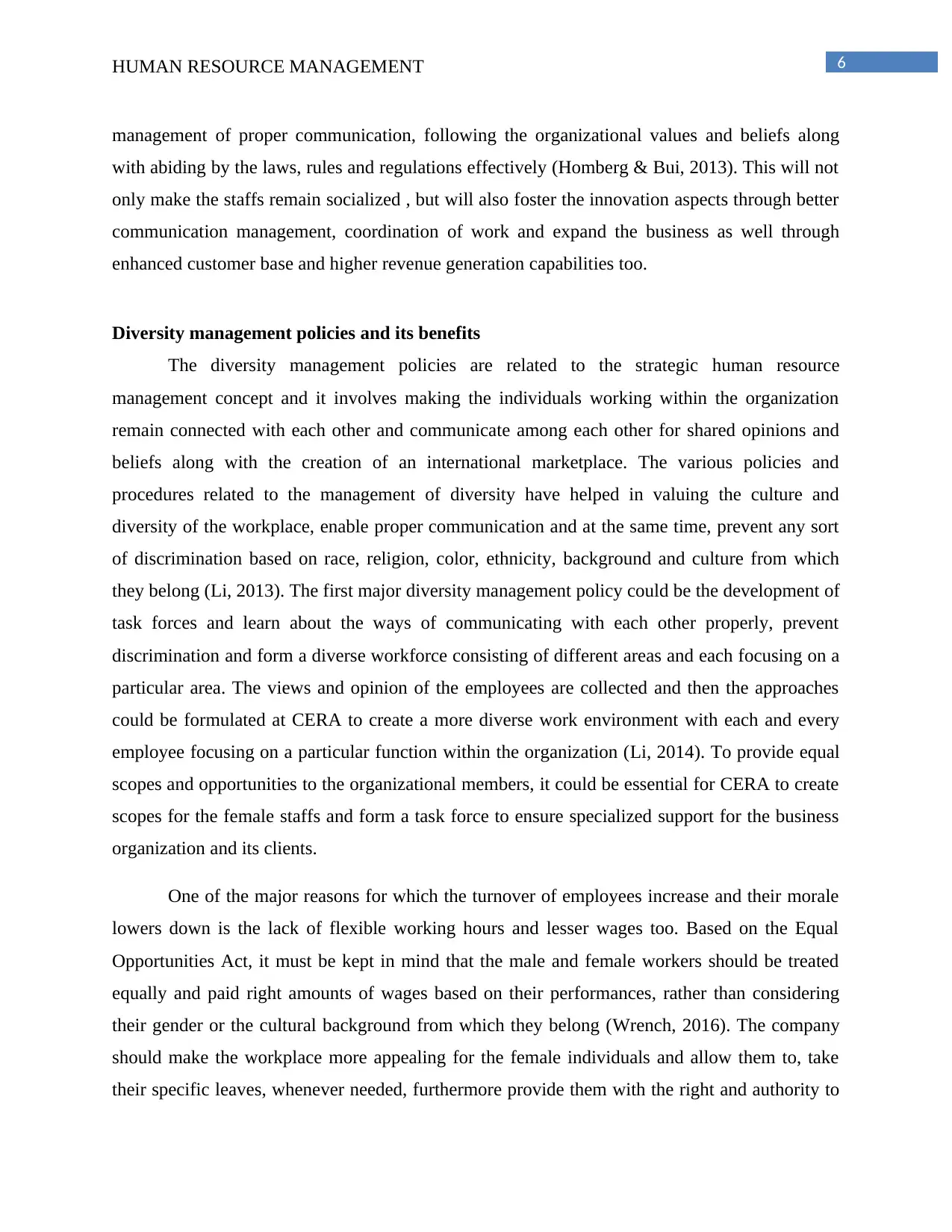
6HUMAN RESOURCE MANAGEMENT
management of proper communication, following the organizational values and beliefs along
with abiding by the laws, rules and regulations effectively (Homberg & Bui, 2013). This will not
only make the staffs remain socialized , but will also foster the innovation aspects through better
communication management, coordination of work and expand the business as well through
enhanced customer base and higher revenue generation capabilities too.
Diversity management policies and its benefits
The diversity management policies are related to the strategic human resource
management concept and it involves making the individuals working within the organization
remain connected with each other and communicate among each other for shared opinions and
beliefs along with the creation of an international marketplace. The various policies and
procedures related to the management of diversity have helped in valuing the culture and
diversity of the workplace, enable proper communication and at the same time, prevent any sort
of discrimination based on race, religion, color, ethnicity, background and culture from which
they belong (Li, 2013). The first major diversity management policy could be the development of
task forces and learn about the ways of communicating with each other properly, prevent
discrimination and form a diverse workforce consisting of different areas and each focusing on a
particular area. The views and opinion of the employees are collected and then the approaches
could be formulated at CERA to create a more diverse work environment with each and every
employee focusing on a particular function within the organization (Li, 2014). To provide equal
scopes and opportunities to the organizational members, it could be essential for CERA to create
scopes for the female staffs and form a task force to ensure specialized support for the business
organization and its clients.
One of the major reasons for which the turnover of employees increase and their morale
lowers down is the lack of flexible working hours and lesser wages too. Based on the Equal
Opportunities Act, it must be kept in mind that the male and female workers should be treated
equally and paid right amounts of wages based on their performances, rather than considering
their gender or the cultural background from which they belong (Wrench, 2016). The company
should make the workplace more appealing for the female individuals and allow them to, take
their specific leaves, whenever needed, furthermore provide them with the right and authority to
management of proper communication, following the organizational values and beliefs along
with abiding by the laws, rules and regulations effectively (Homberg & Bui, 2013). This will not
only make the staffs remain socialized , but will also foster the innovation aspects through better
communication management, coordination of work and expand the business as well through
enhanced customer base and higher revenue generation capabilities too.
Diversity management policies and its benefits
The diversity management policies are related to the strategic human resource
management concept and it involves making the individuals working within the organization
remain connected with each other and communicate among each other for shared opinions and
beliefs along with the creation of an international marketplace. The various policies and
procedures related to the management of diversity have helped in valuing the culture and
diversity of the workplace, enable proper communication and at the same time, prevent any sort
of discrimination based on race, religion, color, ethnicity, background and culture from which
they belong (Li, 2013). The first major diversity management policy could be the development of
task forces and learn about the ways of communicating with each other properly, prevent
discrimination and form a diverse workforce consisting of different areas and each focusing on a
particular area. The views and opinion of the employees are collected and then the approaches
could be formulated at CERA to create a more diverse work environment with each and every
employee focusing on a particular function within the organization (Li, 2014). To provide equal
scopes and opportunities to the organizational members, it could be essential for CERA to create
scopes for the female staffs and form a task force to ensure specialized support for the business
organization and its clients.
One of the major reasons for which the turnover of employees increase and their morale
lowers down is the lack of flexible working hours and lesser wages too. Based on the Equal
Opportunities Act, it must be kept in mind that the male and female workers should be treated
equally and paid right amounts of wages based on their performances, rather than considering
their gender or the cultural background from which they belong (Wrench, 2016). The company
should make the workplace more appealing for the female individuals and allow them to, take
their specific leaves, whenever needed, furthermore provide them with the right and authority to
Paraphrase This Document
Need a fresh take? Get an instant paraphrase of this document with our AI Paraphraser
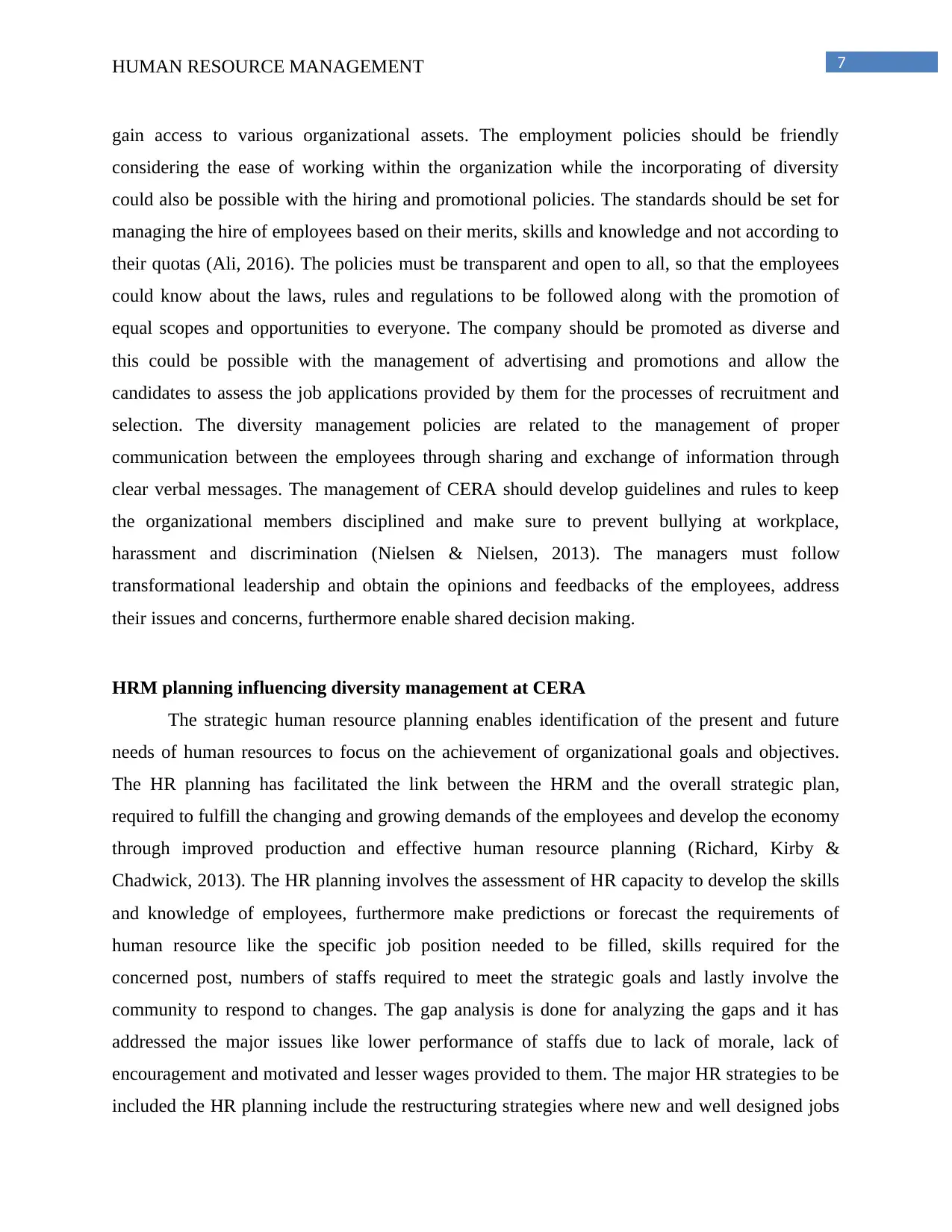
7HUMAN RESOURCE MANAGEMENT
gain access to various organizational assets. The employment policies should be friendly
considering the ease of working within the organization while the incorporating of diversity
could also be possible with the hiring and promotional policies. The standards should be set for
managing the hire of employees based on their merits, skills and knowledge and not according to
their quotas (Ali, 2016). The policies must be transparent and open to all, so that the employees
could know about the laws, rules and regulations to be followed along with the promotion of
equal scopes and opportunities to everyone. The company should be promoted as diverse and
this could be possible with the management of advertising and promotions and allow the
candidates to assess the job applications provided by them for the processes of recruitment and
selection. The diversity management policies are related to the management of proper
communication between the employees through sharing and exchange of information through
clear verbal messages. The management of CERA should develop guidelines and rules to keep
the organizational members disciplined and make sure to prevent bullying at workplace,
harassment and discrimination (Nielsen & Nielsen, 2013). The managers must follow
transformational leadership and obtain the opinions and feedbacks of the employees, address
their issues and concerns, furthermore enable shared decision making.
HRM planning influencing diversity management at CERA
The strategic human resource planning enables identification of the present and future
needs of human resources to focus on the achievement of organizational goals and objectives.
The HR planning has facilitated the link between the HRM and the overall strategic plan,
required to fulfill the changing and growing demands of the employees and develop the economy
through improved production and effective human resource planning (Richard, Kirby &
Chadwick, 2013). The HR planning involves the assessment of HR capacity to develop the skills
and knowledge of employees, furthermore make predictions or forecast the requirements of
human resource like the specific job position needed to be filled, skills required for the
concerned post, numbers of staffs required to meet the strategic goals and lastly involve the
community to respond to changes. The gap analysis is done for analyzing the gaps and it has
addressed the major issues like lower performance of staffs due to lack of morale, lack of
encouragement and motivated and lesser wages provided to them. The major HR strategies to be
included the HR planning include the restructuring strategies where new and well designed jobs
gain access to various organizational assets. The employment policies should be friendly
considering the ease of working within the organization while the incorporating of diversity
could also be possible with the hiring and promotional policies. The standards should be set for
managing the hire of employees based on their merits, skills and knowledge and not according to
their quotas (Ali, 2016). The policies must be transparent and open to all, so that the employees
could know about the laws, rules and regulations to be followed along with the promotion of
equal scopes and opportunities to everyone. The company should be promoted as diverse and
this could be possible with the management of advertising and promotions and allow the
candidates to assess the job applications provided by them for the processes of recruitment and
selection. The diversity management policies are related to the management of proper
communication between the employees through sharing and exchange of information through
clear verbal messages. The management of CERA should develop guidelines and rules to keep
the organizational members disciplined and make sure to prevent bullying at workplace,
harassment and discrimination (Nielsen & Nielsen, 2013). The managers must follow
transformational leadership and obtain the opinions and feedbacks of the employees, address
their issues and concerns, furthermore enable shared decision making.
HRM planning influencing diversity management at CERA
The strategic human resource planning enables identification of the present and future
needs of human resources to focus on the achievement of organizational goals and objectives.
The HR planning has facilitated the link between the HRM and the overall strategic plan,
required to fulfill the changing and growing demands of the employees and develop the economy
through improved production and effective human resource planning (Richard, Kirby &
Chadwick, 2013). The HR planning involves the assessment of HR capacity to develop the skills
and knowledge of employees, furthermore make predictions or forecast the requirements of
human resource like the specific job position needed to be filled, skills required for the
concerned post, numbers of staffs required to meet the strategic goals and lastly involve the
community to respond to changes. The gap analysis is done for analyzing the gaps and it has
addressed the major issues like lower performance of staffs due to lack of morale, lack of
encouragement and motivated and lesser wages provided to them. The major HR strategies to be
included the HR planning include the restructuring strategies where new and well designed jobs
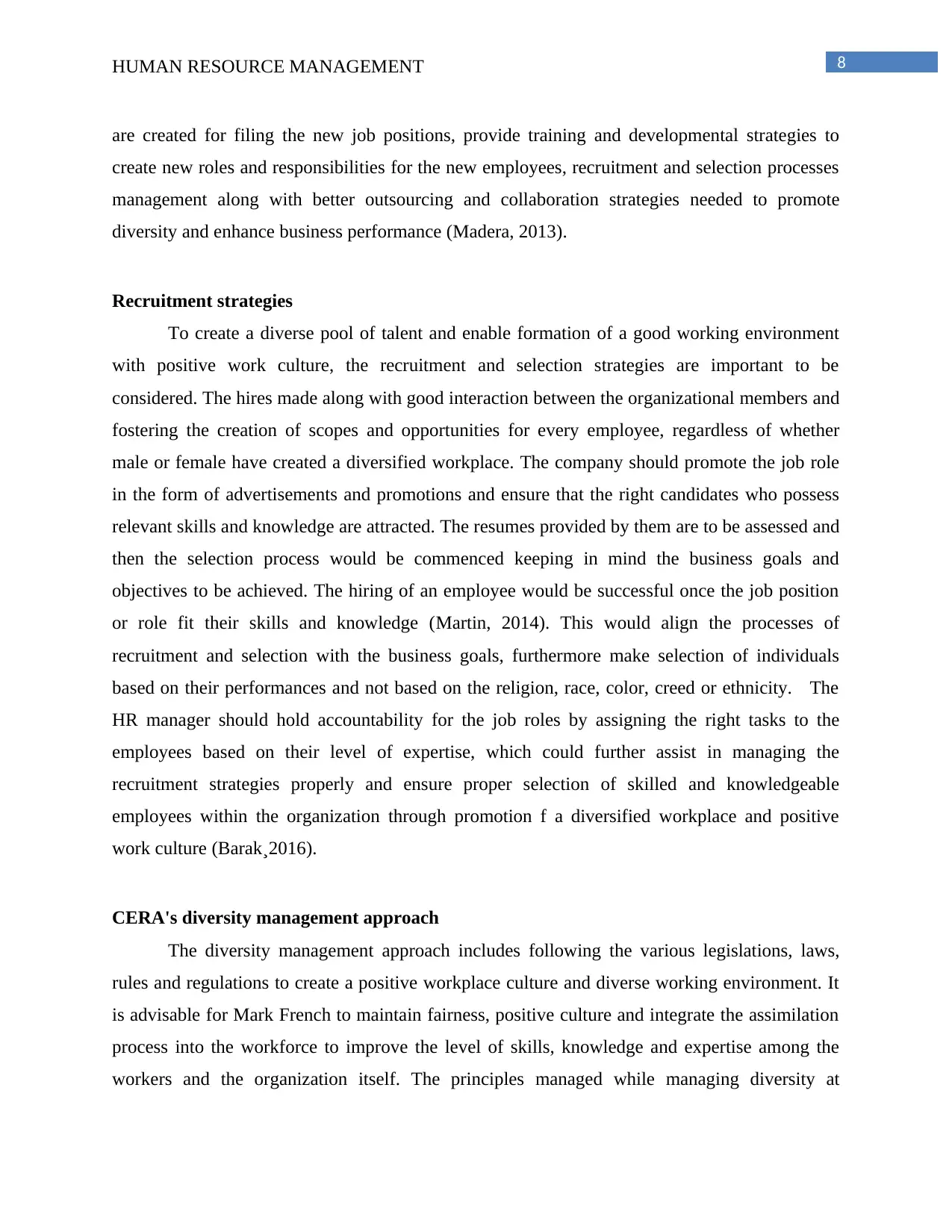
8HUMAN RESOURCE MANAGEMENT
are created for filing the new job positions, provide training and developmental strategies to
create new roles and responsibilities for the new employees, recruitment and selection processes
management along with better outsourcing and collaboration strategies needed to promote
diversity and enhance business performance (Madera, 2013).
Recruitment strategies
To create a diverse pool of talent and enable formation of a good working environment
with positive work culture, the recruitment and selection strategies are important to be
considered. The hires made along with good interaction between the organizational members and
fostering the creation of scopes and opportunities for every employee, regardless of whether
male or female have created a diversified workplace. The company should promote the job role
in the form of advertisements and promotions and ensure that the right candidates who possess
relevant skills and knowledge are attracted. The resumes provided by them are to be assessed and
then the selection process would be commenced keeping in mind the business goals and
objectives to be achieved. The hiring of an employee would be successful once the job position
or role fit their skills and knowledge (Martin, 2014). This would align the processes of
recruitment and selection with the business goals, furthermore make selection of individuals
based on their performances and not based on the religion, race, color, creed or ethnicity. The
HR manager should hold accountability for the job roles by assigning the right tasks to the
employees based on their level of expertise, which could further assist in managing the
recruitment strategies properly and ensure proper selection of skilled and knowledgeable
employees within the organization through promotion f a diversified workplace and positive
work culture (Barak¸2016).
CERA's diversity management approach
The diversity management approach includes following the various legislations, laws,
rules and regulations to create a positive workplace culture and diverse working environment. It
is advisable for Mark French to maintain fairness, positive culture and integrate the assimilation
process into the workforce to improve the level of skills, knowledge and expertise among the
workers and the organization itself. The principles managed while managing diversity at
are created for filing the new job positions, provide training and developmental strategies to
create new roles and responsibilities for the new employees, recruitment and selection processes
management along with better outsourcing and collaboration strategies needed to promote
diversity and enhance business performance (Madera, 2013).
Recruitment strategies
To create a diverse pool of talent and enable formation of a good working environment
with positive work culture, the recruitment and selection strategies are important to be
considered. The hires made along with good interaction between the organizational members and
fostering the creation of scopes and opportunities for every employee, regardless of whether
male or female have created a diversified workplace. The company should promote the job role
in the form of advertisements and promotions and ensure that the right candidates who possess
relevant skills and knowledge are attracted. The resumes provided by them are to be assessed and
then the selection process would be commenced keeping in mind the business goals and
objectives to be achieved. The hiring of an employee would be successful once the job position
or role fit their skills and knowledge (Martin, 2014). This would align the processes of
recruitment and selection with the business goals, furthermore make selection of individuals
based on their performances and not based on the religion, race, color, creed or ethnicity. The
HR manager should hold accountability for the job roles by assigning the right tasks to the
employees based on their level of expertise, which could further assist in managing the
recruitment strategies properly and ensure proper selection of skilled and knowledgeable
employees within the organization through promotion f a diversified workplace and positive
work culture (Barak¸2016).
CERA's diversity management approach
The diversity management approach includes following the various legislations, laws,
rules and regulations to create a positive workplace culture and diverse working environment. It
is advisable for Mark French to maintain fairness, positive culture and integrate the assimilation
process into the workforce to improve the level of skills, knowledge and expertise among the
workers and the organization itself. The principles managed while managing diversity at
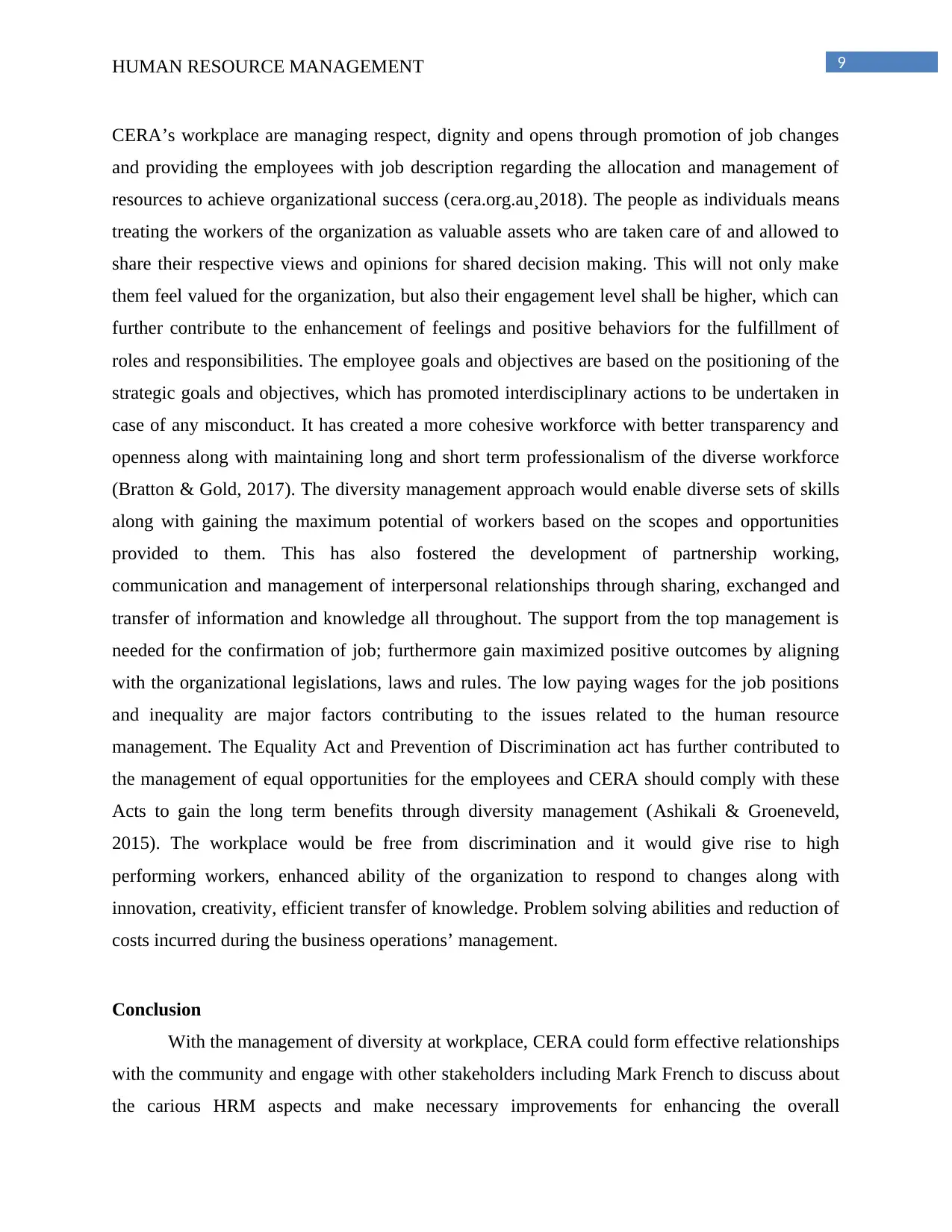
9HUMAN RESOURCE MANAGEMENT
CERA’s workplace are managing respect, dignity and opens through promotion of job changes
and providing the employees with job description regarding the allocation and management of
resources to achieve organizational success (cera.org.au¸2018). The people as individuals means
treating the workers of the organization as valuable assets who are taken care of and allowed to
share their respective views and opinions for shared decision making. This will not only make
them feel valued for the organization, but also their engagement level shall be higher, which can
further contribute to the enhancement of feelings and positive behaviors for the fulfillment of
roles and responsibilities. The employee goals and objectives are based on the positioning of the
strategic goals and objectives, which has promoted interdisciplinary actions to be undertaken in
case of any misconduct. It has created a more cohesive workforce with better transparency and
openness along with maintaining long and short term professionalism of the diverse workforce
(Bratton & Gold, 2017). The diversity management approach would enable diverse sets of skills
along with gaining the maximum potential of workers based on the scopes and opportunities
provided to them. This has also fostered the development of partnership working,
communication and management of interpersonal relationships through sharing, exchanged and
transfer of information and knowledge all throughout. The support from the top management is
needed for the confirmation of job; furthermore gain maximized positive outcomes by aligning
with the organizational legislations, laws and rules. The low paying wages for the job positions
and inequality are major factors contributing to the issues related to the human resource
management. The Equality Act and Prevention of Discrimination act has further contributed to
the management of equal opportunities for the employees and CERA should comply with these
Acts to gain the long term benefits through diversity management (Ashikali & Groeneveld,
2015). The workplace would be free from discrimination and it would give rise to high
performing workers, enhanced ability of the organization to respond to changes along with
innovation, creativity, efficient transfer of knowledge. Problem solving abilities and reduction of
costs incurred during the business operations’ management.
Conclusion
With the management of diversity at workplace, CERA could form effective relationships
with the community and engage with other stakeholders including Mark French to discuss about
the carious HRM aspects and make necessary improvements for enhancing the overall
CERA’s workplace are managing respect, dignity and opens through promotion of job changes
and providing the employees with job description regarding the allocation and management of
resources to achieve organizational success (cera.org.au¸2018). The people as individuals means
treating the workers of the organization as valuable assets who are taken care of and allowed to
share their respective views and opinions for shared decision making. This will not only make
them feel valued for the organization, but also their engagement level shall be higher, which can
further contribute to the enhancement of feelings and positive behaviors for the fulfillment of
roles and responsibilities. The employee goals and objectives are based on the positioning of the
strategic goals and objectives, which has promoted interdisciplinary actions to be undertaken in
case of any misconduct. It has created a more cohesive workforce with better transparency and
openness along with maintaining long and short term professionalism of the diverse workforce
(Bratton & Gold, 2017). The diversity management approach would enable diverse sets of skills
along with gaining the maximum potential of workers based on the scopes and opportunities
provided to them. This has also fostered the development of partnership working,
communication and management of interpersonal relationships through sharing, exchanged and
transfer of information and knowledge all throughout. The support from the top management is
needed for the confirmation of job; furthermore gain maximized positive outcomes by aligning
with the organizational legislations, laws and rules. The low paying wages for the job positions
and inequality are major factors contributing to the issues related to the human resource
management. The Equality Act and Prevention of Discrimination act has further contributed to
the management of equal opportunities for the employees and CERA should comply with these
Acts to gain the long term benefits through diversity management (Ashikali & Groeneveld,
2015). The workplace would be free from discrimination and it would give rise to high
performing workers, enhanced ability of the organization to respond to changes along with
innovation, creativity, efficient transfer of knowledge. Problem solving abilities and reduction of
costs incurred during the business operations’ management.
Conclusion
With the management of diversity at workplace, CERA could form effective relationships
with the community and engage with other stakeholders including Mark French to discuss about
the carious HRM aspects and make necessary improvements for enhancing the overall
Secure Best Marks with AI Grader
Need help grading? Try our AI Grader for instant feedback on your assignments.
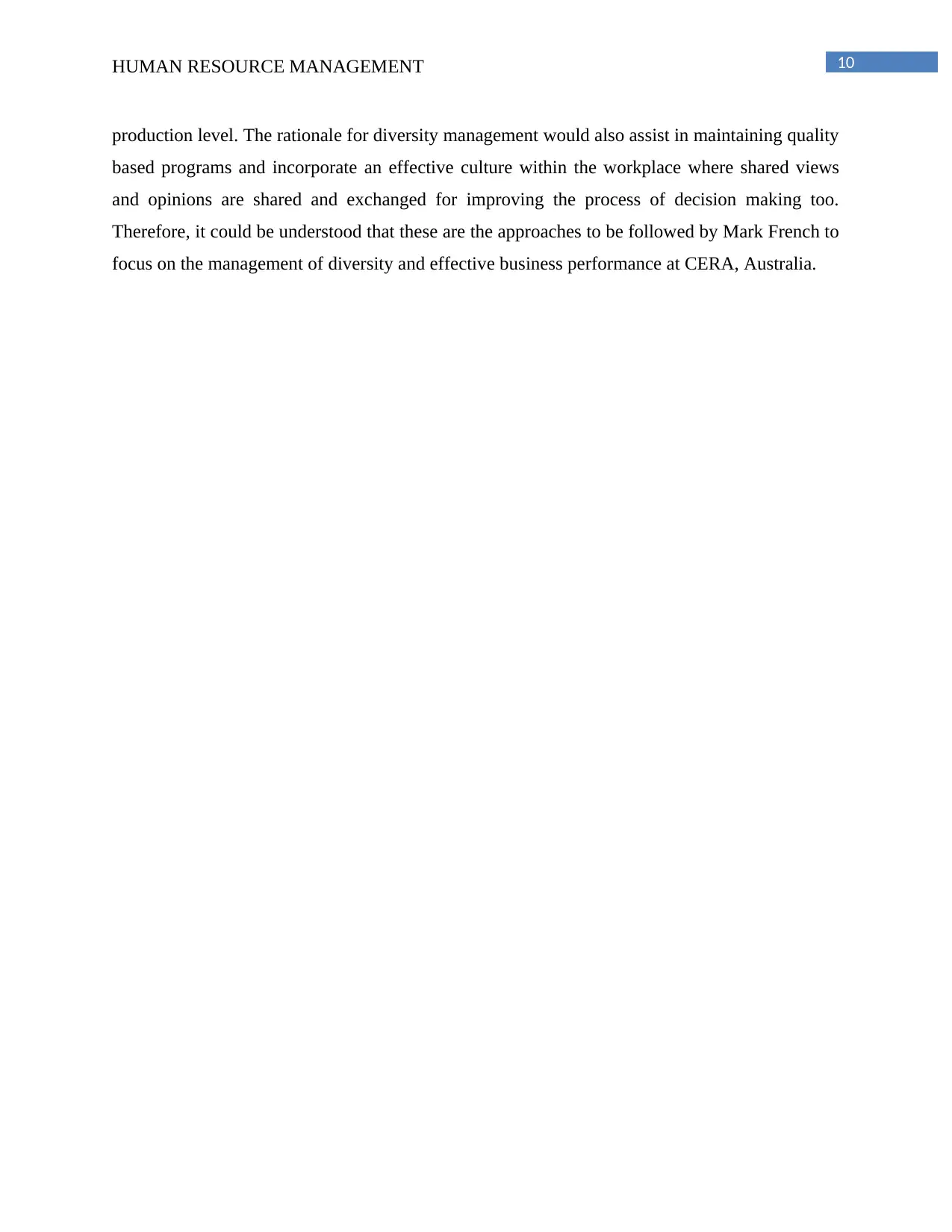
10HUMAN RESOURCE MANAGEMENT
production level. The rationale for diversity management would also assist in maintaining quality
based programs and incorporate an effective culture within the workplace where shared views
and opinions are shared and exchanged for improving the process of decision making too.
Therefore, it could be understood that these are the approaches to be followed by Mark French to
focus on the management of diversity and effective business performance at CERA, Australia.
production level. The rationale for diversity management would also assist in maintaining quality
based programs and incorporate an effective culture within the workplace where shared views
and opinions are shared and exchanged for improving the process of decision making too.
Therefore, it could be understood that these are the approaches to be followed by Mark French to
focus on the management of diversity and effective business performance at CERA, Australia.
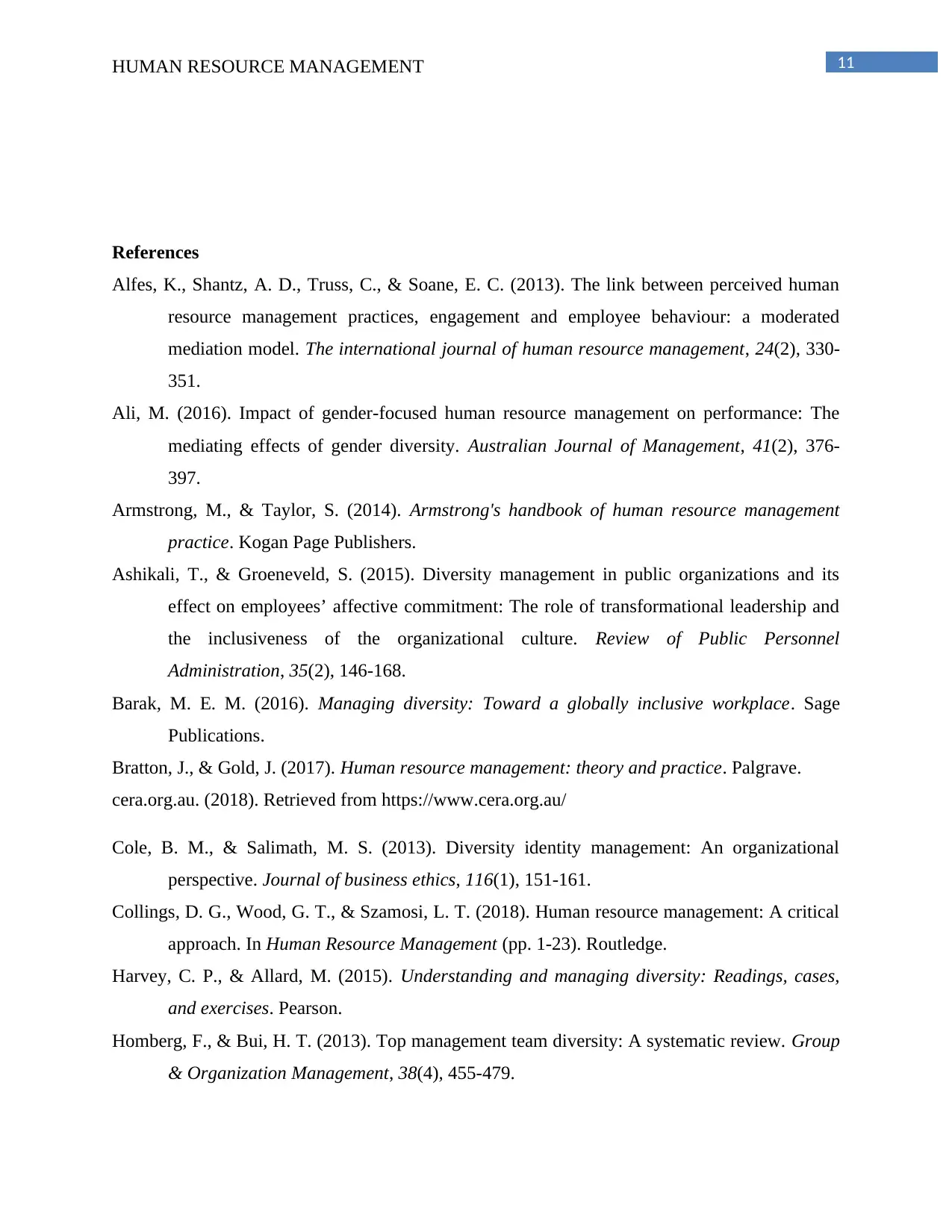
11HUMAN RESOURCE MANAGEMENT
References
Alfes, K., Shantz, A. D., Truss, C., & Soane, E. C. (2013). The link between perceived human
resource management practices, engagement and employee behaviour: a moderated
mediation model. The international journal of human resource management, 24(2), 330-
351.
Ali, M. (2016). Impact of gender-focused human resource management on performance: The
mediating effects of gender diversity. Australian Journal of Management, 41(2), 376-
397.
Armstrong, M., & Taylor, S. (2014). Armstrong's handbook of human resource management
practice. Kogan Page Publishers.
Ashikali, T., & Groeneveld, S. (2015). Diversity management in public organizations and its
effect on employees’ affective commitment: The role of transformational leadership and
the inclusiveness of the organizational culture. Review of Public Personnel
Administration, 35(2), 146-168.
Barak, M. E. M. (2016). Managing diversity: Toward a globally inclusive workplace. Sage
Publications.
Bratton, J., & Gold, J. (2017). Human resource management: theory and practice. Palgrave.
cera.org.au. (2018). Retrieved from https://www.cera.org.au/
Cole, B. M., & Salimath, M. S. (2013). Diversity identity management: An organizational
perspective. Journal of business ethics, 116(1), 151-161.
Collings, D. G., Wood, G. T., & Szamosi, L. T. (2018). Human resource management: A critical
approach. In Human Resource Management (pp. 1-23). Routledge.
Harvey, C. P., & Allard, M. (2015). Understanding and managing diversity: Readings, cases,
and exercises. Pearson.
Homberg, F., & Bui, H. T. (2013). Top management team diversity: A systematic review. Group
& Organization Management, 38(4), 455-479.
References
Alfes, K., Shantz, A. D., Truss, C., & Soane, E. C. (2013). The link between perceived human
resource management practices, engagement and employee behaviour: a moderated
mediation model. The international journal of human resource management, 24(2), 330-
351.
Ali, M. (2016). Impact of gender-focused human resource management on performance: The
mediating effects of gender diversity. Australian Journal of Management, 41(2), 376-
397.
Armstrong, M., & Taylor, S. (2014). Armstrong's handbook of human resource management
practice. Kogan Page Publishers.
Ashikali, T., & Groeneveld, S. (2015). Diversity management in public organizations and its
effect on employees’ affective commitment: The role of transformational leadership and
the inclusiveness of the organizational culture. Review of Public Personnel
Administration, 35(2), 146-168.
Barak, M. E. M. (2016). Managing diversity: Toward a globally inclusive workplace. Sage
Publications.
Bratton, J., & Gold, J. (2017). Human resource management: theory and practice. Palgrave.
cera.org.au. (2018). Retrieved from https://www.cera.org.au/
Cole, B. M., & Salimath, M. S. (2013). Diversity identity management: An organizational
perspective. Journal of business ethics, 116(1), 151-161.
Collings, D. G., Wood, G. T., & Szamosi, L. T. (2018). Human resource management: A critical
approach. In Human Resource Management (pp. 1-23). Routledge.
Harvey, C. P., & Allard, M. (2015). Understanding and managing diversity: Readings, cases,
and exercises. Pearson.
Homberg, F., & Bui, H. T. (2013). Top management team diversity: A systematic review. Group
& Organization Management, 38(4), 455-479.
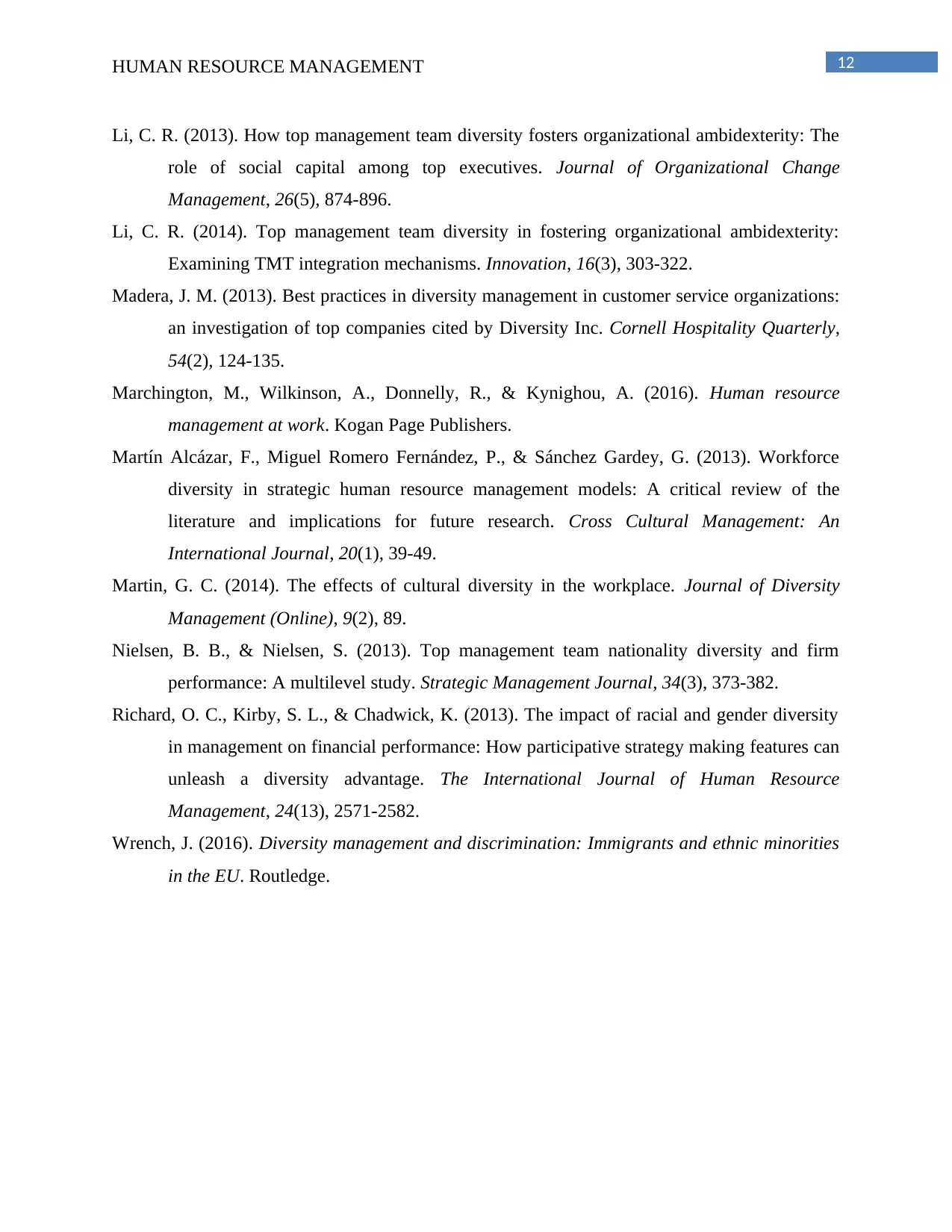
12HUMAN RESOURCE MANAGEMENT
Li, C. R. (2013). How top management team diversity fosters organizational ambidexterity: The
role of social capital among top executives. Journal of Organizational Change
Management, 26(5), 874-896.
Li, C. R. (2014). Top management team diversity in fostering organizational ambidexterity:
Examining TMT integration mechanisms. Innovation, 16(3), 303-322.
Madera, J. M. (2013). Best practices in diversity management in customer service organizations:
an investigation of top companies cited by Diversity Inc. Cornell Hospitality Quarterly,
54(2), 124-135.
Marchington, M., Wilkinson, A., Donnelly, R., & Kynighou, A. (2016). Human resource
management at work. Kogan Page Publishers.
Martín Alcázar, F., Miguel Romero Fernández, P., & Sánchez Gardey, G. (2013). Workforce
diversity in strategic human resource management models: A critical review of the
literature and implications for future research. Cross Cultural Management: An
International Journal, 20(1), 39-49.
Martin, G. C. (2014). The effects of cultural diversity in the workplace. Journal of Diversity
Management (Online), 9(2), 89.
Nielsen, B. B., & Nielsen, S. (2013). Top management team nationality diversity and firm
performance: A multilevel study. Strategic Management Journal, 34(3), 373-382.
Richard, O. C., Kirby, S. L., & Chadwick, K. (2013). The impact of racial and gender diversity
in management on financial performance: How participative strategy making features can
unleash a diversity advantage. The International Journal of Human Resource
Management, 24(13), 2571-2582.
Wrench, J. (2016). Diversity management and discrimination: Immigrants and ethnic minorities
in the EU. Routledge.
Li, C. R. (2013). How top management team diversity fosters organizational ambidexterity: The
role of social capital among top executives. Journal of Organizational Change
Management, 26(5), 874-896.
Li, C. R. (2014). Top management team diversity in fostering organizational ambidexterity:
Examining TMT integration mechanisms. Innovation, 16(3), 303-322.
Madera, J. M. (2013). Best practices in diversity management in customer service organizations:
an investigation of top companies cited by Diversity Inc. Cornell Hospitality Quarterly,
54(2), 124-135.
Marchington, M., Wilkinson, A., Donnelly, R., & Kynighou, A. (2016). Human resource
management at work. Kogan Page Publishers.
Martín Alcázar, F., Miguel Romero Fernández, P., & Sánchez Gardey, G. (2013). Workforce
diversity in strategic human resource management models: A critical review of the
literature and implications for future research. Cross Cultural Management: An
International Journal, 20(1), 39-49.
Martin, G. C. (2014). The effects of cultural diversity in the workplace. Journal of Diversity
Management (Online), 9(2), 89.
Nielsen, B. B., & Nielsen, S. (2013). Top management team nationality diversity and firm
performance: A multilevel study. Strategic Management Journal, 34(3), 373-382.
Richard, O. C., Kirby, S. L., & Chadwick, K. (2013). The impact of racial and gender diversity
in management on financial performance: How participative strategy making features can
unleash a diversity advantage. The International Journal of Human Resource
Management, 24(13), 2571-2582.
Wrench, J. (2016). Diversity management and discrimination: Immigrants and ethnic minorities
in the EU. Routledge.
1 out of 13
Related Documents
Your All-in-One AI-Powered Toolkit for Academic Success.
+13062052269
info@desklib.com
Available 24*7 on WhatsApp / Email
![[object Object]](/_next/static/media/star-bottom.7253800d.svg)
Unlock your academic potential
© 2024 | Zucol Services PVT LTD | All rights reserved.





